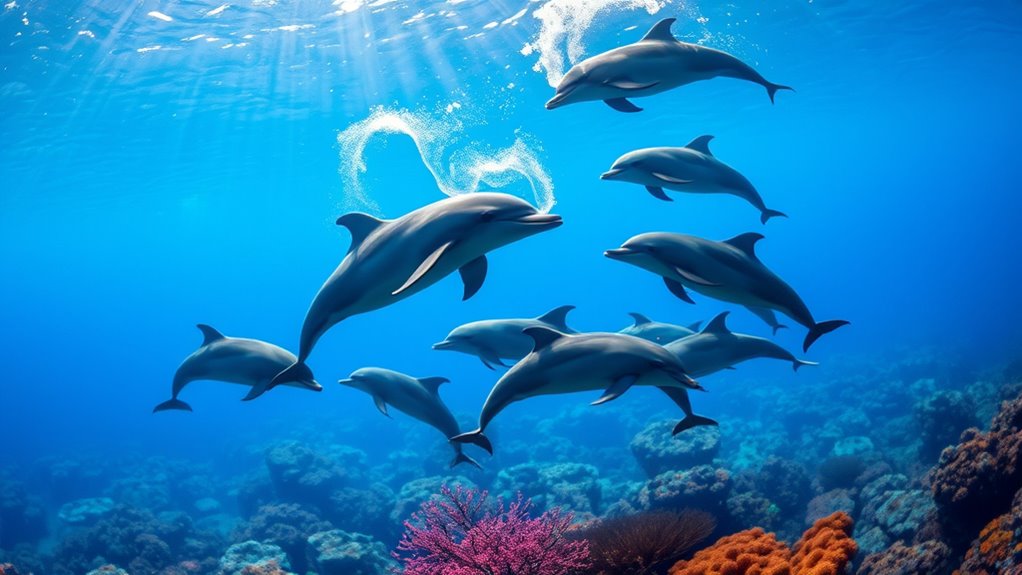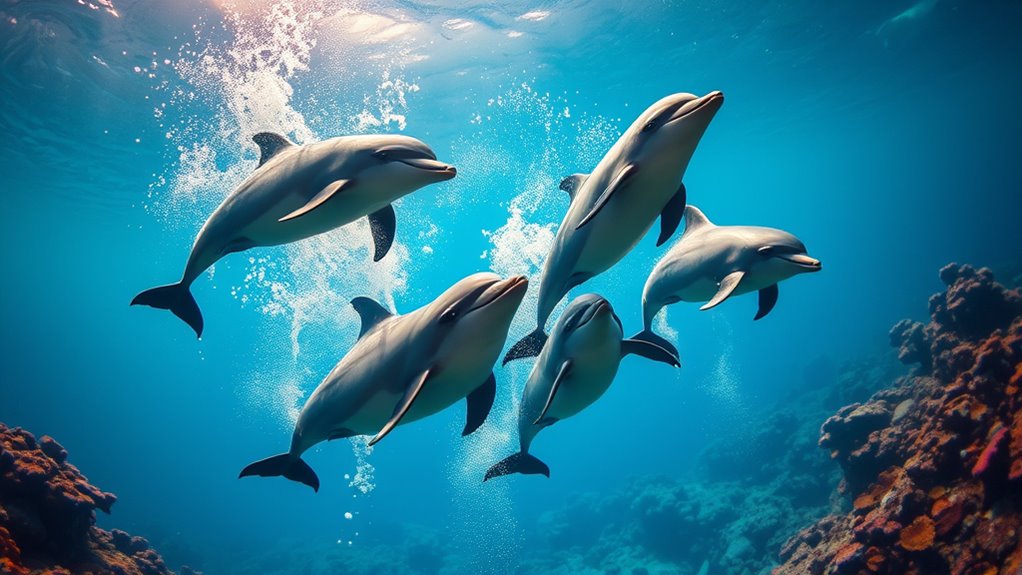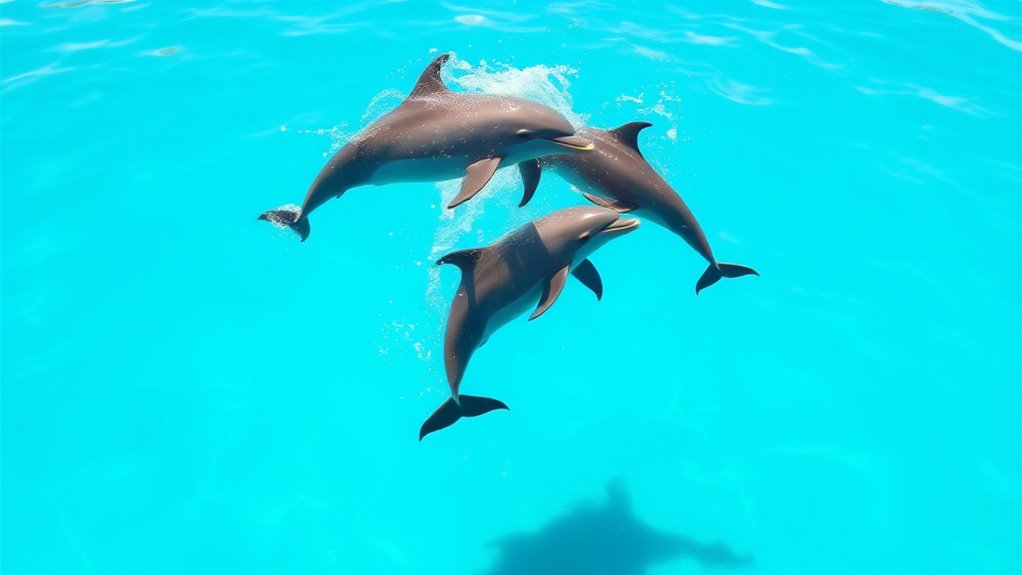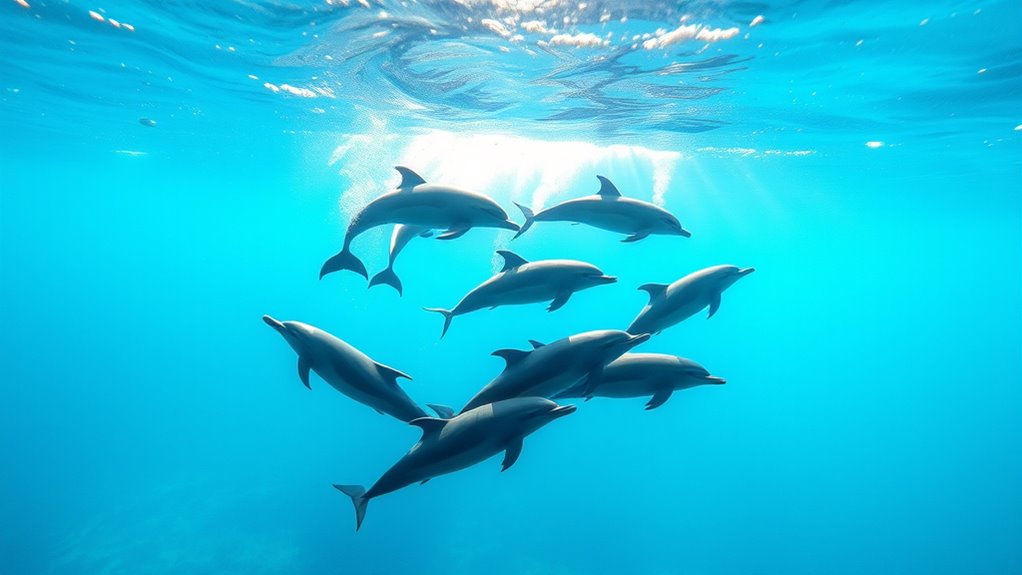Dolphins communicate using a mix of signature whistles, echolocation, and nonverbal cues. Each dolphin has its unique whistle, which helps identify them within their social groups. They use clicks to navigate and find food, adjusting their sound for better precision. Nonverbal cues like tail slapping or breaching express emotions and intentions. By synchronizing their movements and vocalizations, dolphins enhance teamwork and social bonds. There's much more to explore about their fascinating communication methods.
Key Takeaways
- Dolphins use signature whistles as unique names for identification and social bonding within their pods.
- They employ echolocation by producing clicks to navigate and detect objects in their underwater environment.
- A complex whistle language facilitates social interactions, especially during foraging activities.
- Nonverbal communication, including tail slapping and breaching, conveys emotions and intentions among dolphins.
- Synchronized movements and vocal cues enhance teamwork and coordination during cooperative tasks.
Signature Whistles

Signature whistles act like names for dolphins, allowing them to identify one another within their social groups. These distinctive high-pitched whistles, developed by individual bottlenose dolphins, emerge around two years of age.
While many remain stable, some dolphins change their signature whistles over time, reflecting social dynamics. Males, for instance, may modify their whistles when forming alliances, showcasing the complexity of dolphin language.
Some dolphins adapt their signature whistles over time, highlighting their social dynamics and the complexity of their communication.
Dolphins communicate by exchanging signature whistles with pod members, reinforcing social bonds and facilitating interactions. Research shows dolphins can even imitate the signature whistles of close companions, demonstrating their keen ability for individual identification within their social circles.
This unique communication method highlights the rich social lives of dolphins and their intricate relationships.
Echolocation

Echolocation is a remarkable ability that allows dolphins to navigate their underwater world with incredible precision. By producing clicks that travel through water, dolphins can detect the location and shape of various objects, including food.
The sound waves they emit reflect off these objects and return to the dolphin's lower jaw, helping them interpret distance and density. This means they can differentiate between objects, like a ping-pong ball and a golf ball.
Since sound travels over four times faster in water than in air, echolocation is highly effective. Dolphins can even adjust the frequency and intensity of their clicks, optimizing their ability to locate food and navigate through their complex aquatic environment.
Social Communication

Dolphins possess a fascinating array of vocalizations and behaviors that enhance their social interactions. Through the Dolphin Communication Project, researchers found that bottlenose dolphins use a complex whistle language, including signature whistles that convey identity and strengthen bonds within their pods.
During social interactions, dolphins increase their vocalizations, especially while foraging, which promotes teamwork and safety. They also engage in non-vocal communication methods, like tail slapping and breaching, to express emotions or signal alerts.
This combination of vocal and non-vocal communication allows dolphins to synchronize their actions, making them unique among non-human animals. By using these strategies, dolphins effectively coordinate group activities and deepen their social connections.
The Role of Nonverbal Cues

While vocalizations play a significant role in dolphin communication, nonverbal cues are equally essential in conveying emotions and intentions.
Dolphins use nonverbal communication methods like body language to express themselves when sounds aren't enough. Tail slapping, for instance, signals discontent or alerts pod members to potential threats. Breaching, where dolphins leap from the water, communicates location or aids in herding prey.
Physical contact, such as fin caresses, strengthens social bonds, while ramming can indicate aggression or competition. Visual signals like arching and head shaking reveal agitation or playfulness, enriching social interactions within pods.
Synchronization and Coordination

When it comes to synchronized movements, dolphins exhibit remarkable coordination that highlights their advanced communication skills. These marine mammals utilize clicks and whistles to synchronize their actions, often jumping together with impressive precision.
Dolphins showcase extraordinary synchronized movements, demonstrating their advanced communication skills through precise clicks and whistles.
Their ability to communicate through vocal cues sets them apart from other animals, showcasing a unique level of teamwork.
- Dolphins can match breathing patterns and movements perfectly.
- Dominant females initiate synchronized actions with precise vocal cues.
- Increased whistling enhances the likelihood of successful coordination.
- They engage in cooperative tasks, like pushing buttons, while synchronizing.
This level of communication allows dolphins to work together efficiently, demonstrating their intelligence and social dynamics as they navigate their underwater world.
Frequently Asked Questions
What Are Some Interesting Facts About Dolphins Communication?
Dolphins have some fascinating ways to communicate. You might be surprised to learn they develop unique signature whistles by age two, which help them identify each other.
They can also imitate sounds and learn new whistles, strengthening their social bonds. Since sound travels faster in water, dolphins can coordinate their actions over long distances.
Plus, they often synchronize movements using vocal cues, showcasing their impressive social cooperation skills.
How Do Dolphins Cooperate With Each Other?
Imagine watching a group of dolphins, seemingly in sync, as they swim together.
You'll notice their remarkable ability to cooperate through vocal sounds. They use clicks and whistles to coordinate their movements, especially during hunting or playful activities.
It's fascinating how they can match breathing patterns and actions, enhancing their teamwork. This sophisticated communication not only strengthens bonds but also boosts their chances of success, proving that cooperation among dolphins is truly extraordinary.
What Do Dolphins Use Such as Clicking to Communicate With Each Other?
Dolphins use clicks as a primary means of communication, and you'll find they modify these sounds to express different emotions or intentions.
When you're observing them, notice how their clicks vary in frequency and pattern, allowing them to convey messages effectively within their pods.
These clicks are also essential for echolocation, helping them navigate and locate objects in their environment while coordinating during hunting, making their communication both versatile and important.
How Do Dolphins Show Affection to Each Other?
Did you know that dolphins can swim up to 25 miles per hour?
They show affection in various ways. You might see them caress each other with their fins or rub against one another, strengthening their social bonds.
Mothers and calves maintain close connections through vocalizations and physical touch. Playful activities, like surfing waves together, also highlight their affectionate nature, as does breaching, which expresses excitement and joy within their pods.
Conclusion
In the vast ocean tapestry, dolphins weave their stories through signature whistles and playful clicks, creating a symphony of sound. Their social bonds shimmer like sunlight on water, strengthened by nonverbal cues and synchronized movements. As you immerse yourself in their world, you realize communication isn't just about words; it's a dance of connection, a fluid language that transcends barriers. So, next time you hear a dolphin's call, remember—it's their way of sharing the beauty of life beneath the waves.










